
|
|
Font Size:
|
||||
|
|
|
|
||||
STATISTICAL BRIEF #75:
Access to Needed Medical Care among Children under 18 Years of Age with Special Health Care Needs, 2002
Highlights
- While children with special health care needs comprise 19.4 percent of all children in 2002, they accounted for 44.9 percent of all children's total expenditures for health care.
- A larger percentage of children with special health care needs than of children without special health care needs needed care right away (36.6 percent versus 23.6 percent).
- Of those children needing care right away, the percentage always receiving the needed care as soon as they wanted was lower for children with special health care needs than for children without special health care needs (72.7 percent versus 79.5 percent).
- Children with special health care needs were almost four times as likely as children without special health care needs to have doctors or parents think they needed to see a specialist (42.6 percent versus 11.5 percent).
- Of children needing to see a specialist, those with special health care needs were less likely to have parents report not having a problem in getting a referral to a specialist than children without special health care needs (72.8 percent versus 78.6 percent).
Introduction
The quality of the health care received by children in America is an issue of public policy concern for several reasons. First, the quality of the health care delivery system is critical for maintaining the health and well-being of children. In addition, all children may not be receiving care equally. Following subgroups of children over time can provide information about whether greater equity has been achieved or whether serious gaps remain. Because the Agency for Healthcare Research and Quality (AHRQ) was mandated to measure health care quality for a National Healthcare Quality Report starting in 2003, a variety of health status measures (including the children with special health care needs screener questionnaire) and quality of care measures were added to the Household Component of the Medical Expenditure Panel Survey (MEPS-HC) in 2000.
This Statistical Brief examines the quality of health care for children with and without special health care needs (SHCN) as it pertains to getting needed care in 2002. The estimates provided in the brief reflect getting needed care as it is defined and reported by the parent or knowledgeable adult respondent to the 2002 MEPS-HC.
The following quality measures are examined for each child in the family: 1) whether or not the child had an illness, injury, or condition that needed care right away from a clinic, emergency room or doctor's office, and how timely those needs were met; 2) whether or not the child went to a doctor's office or clinic; needed care, tests, or treatment; and the extent of the problem in receiving the needed care, tests, or treatment; and 3) whether or not the child needed to see a specialist and the extent of the problem in getting a referral to a specialist. Only differences that are statistically significant at the 0.05 level are discussed in the text.
Findings
In 2002, there were an estimated 72.7 million children less than 18 years of age in the U.S. civilian noninstitutionalized population. Of these children, an estimated 19.4 percent (14.1 million children) were reported as having special health care needs (SHCN). While children with special health care needs comprise 19.4 percent of all children, they accounted for 44.9 percent of all children's total expenditures for health care (data not shown).
Needing care right away and getting it as soon as wanted
Overall, 26.2 percent of children under age 18 were reported to have an illness, injury, or condition that needed care right away from a clinic, emergency room, or doctor's office (figure 1). An estimated 77.6 percent of these children had parents report that they always received care as soon as wanted (figure 2).
Children with SHCN were more likely than children without SHCN to have their parents report their having an illness, injury, or condition that needed care right away (36.6 percent and 23.6 percent, respectively) (figure 1). Although more likely than children without SHCN to have parents report their need for care right away, children with SHCN were slightly less likely than children without SHCN to have parents report they always received the needed care as soon as wanted (72.7 percent and 79.5 percent, respectively) (figure 2).
Problems receiving needed care
An estimated 76.6 percent of children under age 18 were reported to have one or more visits to a doctor's office or clinic in the last 12 months (figure 3); and of these children, an estimated 53.9 percent had parents or doctors who believed the children needed care, tests, or treatments (figure 4). Of these children with visits and whose parents or doctors thought they needed care, tests, or treatments, getting the necessary care was reported as a big problem for 3.5 percent of children, a small problem for 8.0 percent, and not a problem for 88.5 percent (figure 5).
When analyzing these data by SHCN status, children with SHCN were more likely than children without SHCN to have one or more doctor's visits in the last 12 months (90.2 percent versus 73.2 percent) (figure 3); and of children with visits, those with SHCN were more likely than those without SHCN to have their parents or doctors believe they needed care, tests, or treatments (76.8 percent versus 46.8 percent) (figure 4). Of children with visits and whose parents or doctors believed they needed care, tests, or treatments, those with SHCN were more than twice as likely as children without SHCN to have their parents report a big problem in receiving the necessary care (5.6 percent versus 2.6 percent) and were less likely to have their parents report not having a problem in receiving the necessary care (83.6 percent versus 90.7 percent) (figure 5).
Problems in getting a referral to a specialist
Specialists are doctors like surgeons, allergy doctors, skin doctors, and others who specialize in one area of health care. Overall, 17.7 percent of children under age 18 had a reported need to see a specialist in the last 12 months (figure 6). Many health insurance plans require a referral from a primary care provider before a specialist can be seen. Of those children needing to see a specialist, getting a referral was reported as not a problem for 75.8 percent of all children (figure 7).
Children with SHCN were almost four times as likely as children without SHCN to have parents report they needed to see a specialist (42.6 percent versus 11.5 percent) (figure 6). Of children needing to see a specialist, those with SHCN were less likely than children without SHCN to have parents report not having a problem in getting a referral to a specialist, though the difference was not large (72.8 percent and 78.6 percent, respectively) (figure 7).
Data Source
Data presented in this Statistical Brief are drawn from the MEPS-HC 2002 Full Year Consolidated Data File (HC-070). The quality of care questions and the children with SHCN instrument are contained in the Child Health and Preventive Care section of the 2002 MEPS-HC. Specific item nonresponse rates for the quality measures were less than .01 percent.
Definitions
Children with special health care needs
Studying health care needs and quality of care for children with chronic conditions has always been difficult due to the low prevalence of most health conditions for children and resulting small sample sizes in national surveys (Perrin, 2002; Bethell et al., 2002; Mangione-Smith and McBlynn, 1998). To address this problem, a standard definition of children with special health care needs was developed (Bethell et al., 2002; McPherson et al., 1998) and operationalized into a children with SHCN screener questionnaire (Bethell et al., 2002). This screener was included in the MEPS-HC Parent Administered Questionnaire (PAQ) in 2000 and has been in the Child Health and Preventive Care section of MEPS-HC since 2001.
The children with SHCN screener questionnaire consists of a series of question-sequences for each of five health domains (Bethell et al., 2002): 1) the need or use of medicines prescribed by a doctor; 2) the need or use of more medical care, mental health, or education services than is usual for most children; 3) being limited or prevented in doing things most children can do; 4) the need or use of special therapy such as physical, occupational, or speech therapy; and 5) the need or use of treatment or counseling for emotional, developmental, or behavioral problems. Children with positive responses to at least one of the five health domains, along with all of the follow-up questions for that domain, were identified as having an SHCN. Children with a "no" response for at least one question for each of the five domains were considered not to have an SHCN. Those children whose "special health care need" status could not be determined (due to missing data for some of the questions) were coded as unknown SHCN status (0.85 percent of children in 2002).
Needing medical care
Children's health care quality measures were included in the 2000 PAQ and have been in the Child Health and Preventive Care section of MEPS-HC since 2001. These quality measures were taken from the health plan version of CAHPS®, an AHRQ-sponsored family of survey instruments designed to measure quality of care from the consumer's perspective. The PAQ was and the Child Health and Preventive Care section is administered in the second half of the respective year. All of the questions refer to events experienced in the last 12 months.
The following quality measures are examined for each child in the family: 1) whether or not the child had an illness, injury, or condition that needed care right away from a clinic, emergency room or doctor's office, and how timely those needs were met; 2) whether or not the child went to a doctor's office or clinic; needed care, tests, or treatment; and the extent of the problem in receiving the needed care, tests, or treatment; and 3) whether or not the child needed to see a specialist and the extent of the problem in getting a referral to a specialist.
More information about the 2000-2002 children's CAHPS® questions in the MEPS-HC and any changes to these variables are contained in the documentation for the respective year's MEPS-HC public use file. More information about CAHPS® can be obtained through the CAHPS® Web site (https://www.cahps.ahrq.gov) or on the AHRQ Web site (http://www.ahrq.gov).
About MEPS-HC
MEPS-HC is a nationally representative longitudinal survey that collects detailed information on health care utilization and expenditures, health insurance, and health status, as well as a wide variety of social, demographic, and economic characteristics for the civilian noninstitutionalized population. It is cosponsored by the Agency for Healthcare Research and Quality and the National Center for Health Statistics.
For more information about MEPS, call the MEPS information coordinator at AHRQ (301-427-1656) or visit the MEPS Web site at http://www.meps.ahrq.gov/.
References
Bethell, C. D., Read, D. S., Stein, R. E. K., Blumberg, S. J., Wells, N., and Newacheck, P. W. Identifying children with special health care needs: Development and evaluation of a short screening instrument. Ambulatory Pediatrics, January-February 2002: Vol. 2, No. 1:38-48.
Mangione-Smith, R. and McGlynn, E.A. Assessing the quality of health care provided to children. Health Services Research, October 1998: 33(4 Pt 2):1059-90.
McPherson, M., Arango, P., Fox, H., Lauver, C., McManus, M., Newacheck, P. W., Perrin, J. M., Shonkoff, J. P., and Strickland, B. A new definition of children with special health care needs. Pediatrics, July 1998: 102(1Pt 1):137-40.
Perrin, J. M. Health services research for children with disabilities. Milbank Quarterly, 2002, Vol. 80, No. 2:303-324.
For a detailed description of the MEPS-HC survey design, sample design, and methods used to minimize sources on nonsampling error, see the following publications:
Cohen, J. Design and Methods of the Medical Expenditure Panel Survey Household Component. Rockville (MD): Agency for Health Care Policy and Research, 1997. MEPS Methodology Report No. 1. AHCPR Pub. No. 97-0026.
Cohen, S. B. Sample Design of the 1997 Medical Expenditure Panel Survey Household Component. Rockville (MD): Agency for Healthcare Research and Quality, 2000. MEPS Methodology Report No. 11. AHRQ Pub. No. 01-0001.
Cohen, S. Design strategies and innovations in the Medical Expenditure Panel Survey. Medical Care, July 2003: 41(7) Supplement: III-5-III-12.
Suggested Citation
Chevarley, F. M. Access to Needed Medical Care among Children under 18 Years of Age with Special Health Care Needs, 2002. Statistical Brief #75. April 2005. Agency for Healthcare Research and Quality, Rockville, Md. http://meps.ahrq.gov/mepsweb/data_files/publications/st75/stat75.shtml
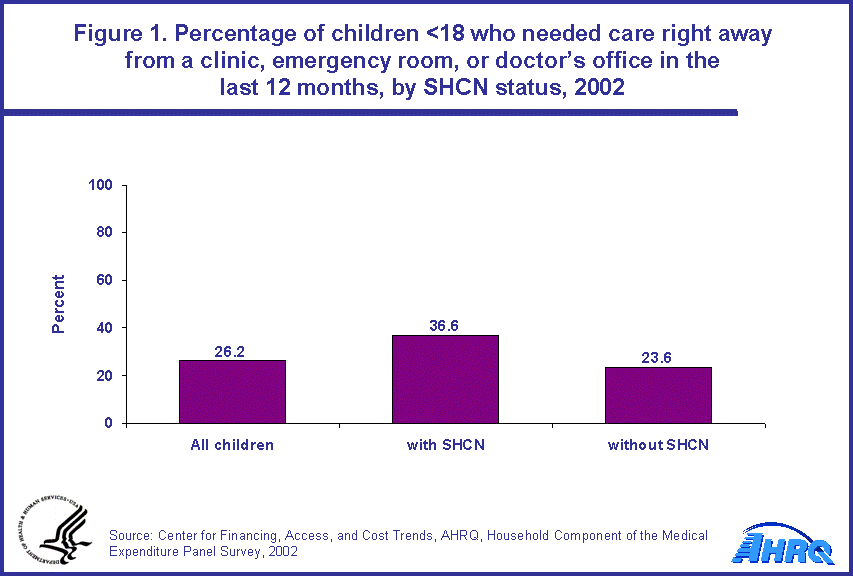 |
||||||||||||||||||||||||
|
||||||||||||||||||||||||
|
|
||||||||||||||||||||||||
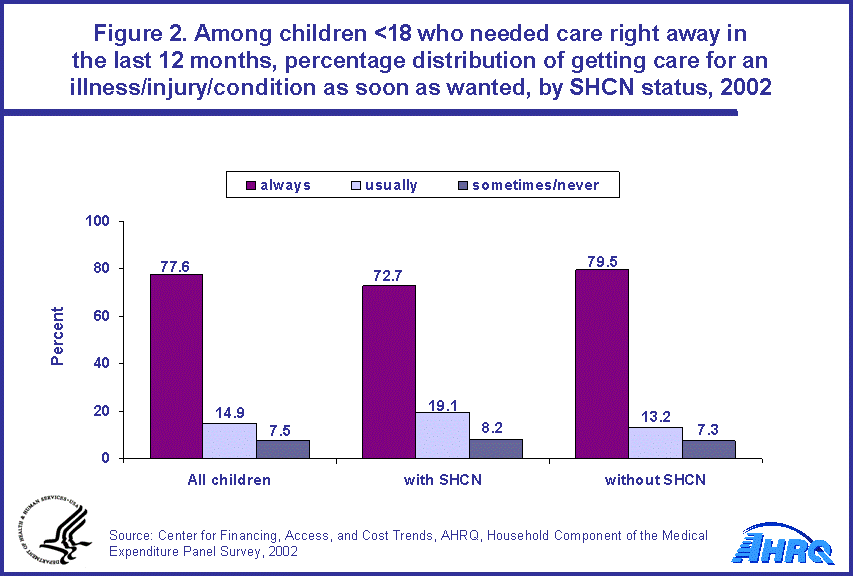 |
||||||||||||||||||||||||
|
||||||||||||||||||||||||
|
|
||||||||||||||||||||||||
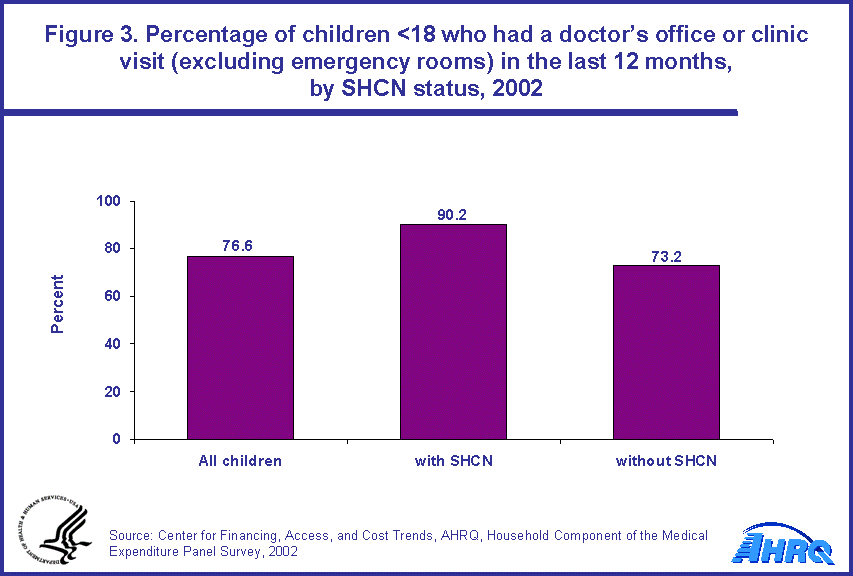 |
||||||||||||||||||||||||
|
||||||||||||||||||||||||
|
|
||||||||||||||||||||||||
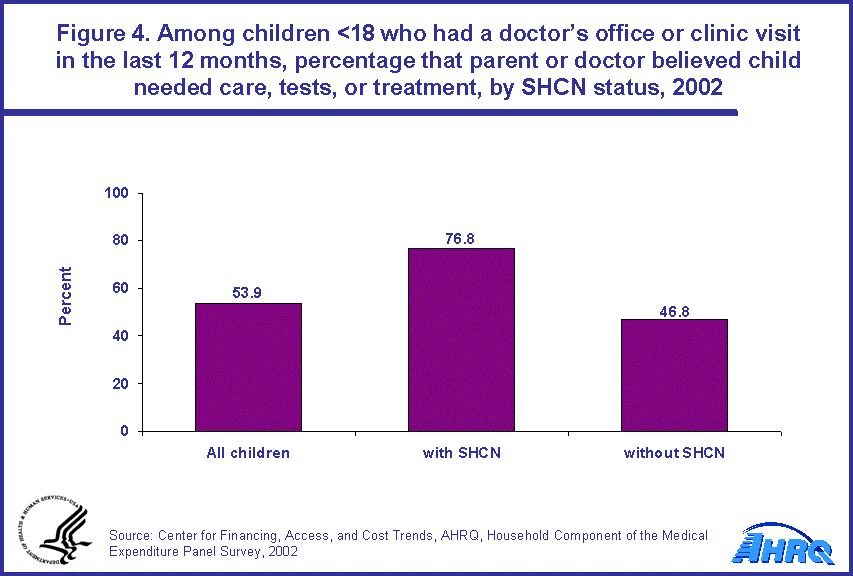 |
||||||||||||||||||||||||
|
||||||||||||||||||||||||
|
|
||||||||||||||||||||||||
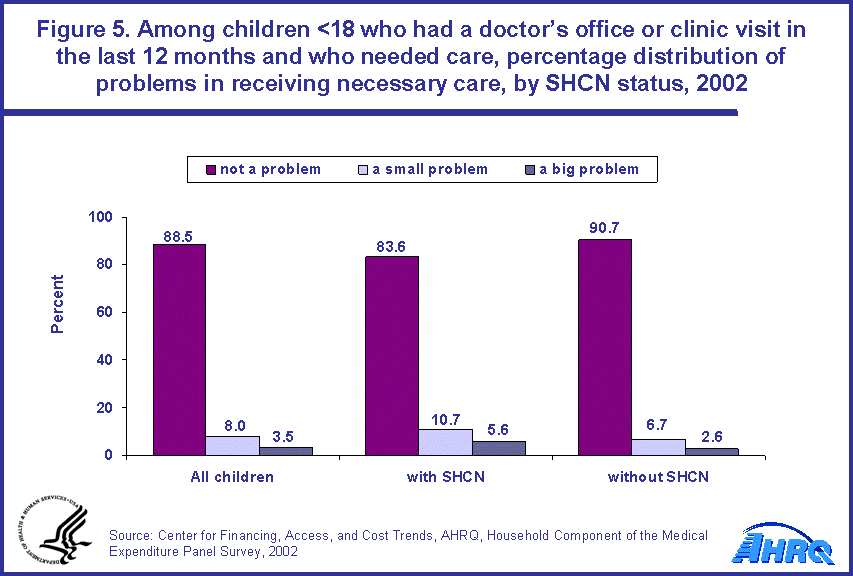 |
||||||||||||||||||||||||
|
||||||||||||||||||||||||
|
|
||||||||||||||||||||||||
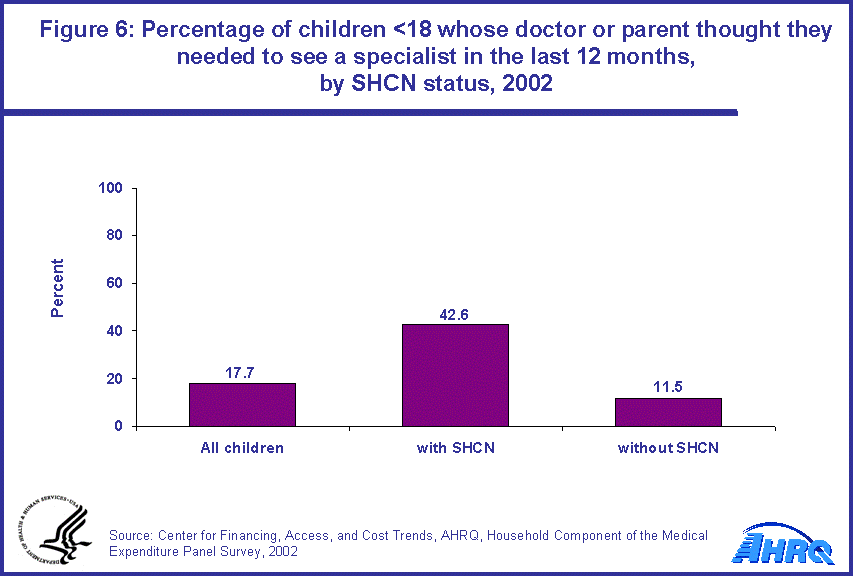 |
||||||||||||||||||||||||
|
||||||||||||||||||||||||
|
|
||||||||||||||||||||||||
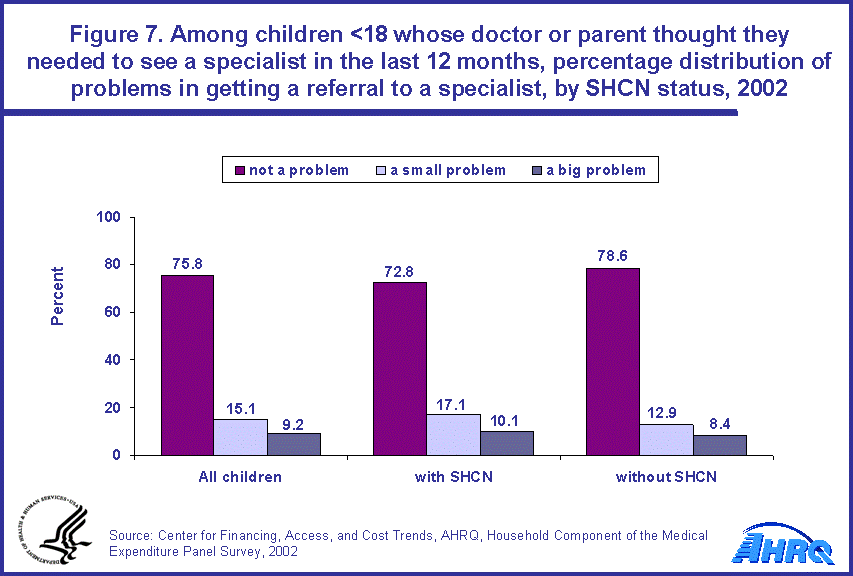 |
||||||||||||||||||||||||
|
||||||||||||||||||||||||
|
|
||||||||||||||||||||||||


